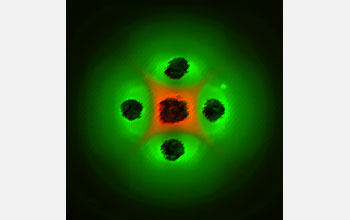Multimedia Gallery
Engineering an Ecosystem
Predator bacteria (green) surround prey bacteria (red) in this Petri dish version of the Serengeti. Rather than eating their prey, however, predator cells release a chemical that activates a suicide gene in the prey. Prey cells also release a chemical, but one that promotes survival of the predators. Researchers genetically programmed the cells to communicate with each other in this way and function as a synthetic ecosystem. The artificial system acts as an experimental model, and can help us understand behaviors in more complex, natural ecosystems.
Bioengineers Lingchong You of Duke University and Frances Arnold of the California Institute of Technology developed an artificial ecosystem made up of two bacterial populations to see if complex interactions found in larger ecosystems--like the Serengeti--could be created in simpler organisms. You was a postdoc in Arnolds lab at CalTech at the time this research was performed. (Date of Image: 2009)
Credit: Song Hao, Lingchong You, Duke University
Images and other media in the National Science Foundation Multimedia Gallery are available for use in print and electronic material by NSF employees, members of the media, university staff, teachers and the general public. All media in the gallery are intended for personal, educational and nonprofit/non-commercial use only.
Images credited to the National Science Foundation, a federal agency, are in the public domain. The images were created by employees of the United States Government as part of their official duties or prepared by contractors as "works for hire" for NSF. You may freely use NSF-credited images and, at your discretion, credit NSF with a "Courtesy: National Science Foundation" notation.
Additional information about general usage can be found in Conditions.
Also Available:
Download the high-resolution JPG version of the image. (2.1 MB)
Use your mouse to right-click (Mac users may need to Ctrl-click) the link above and choose the option that will save the file or target to your computer.

